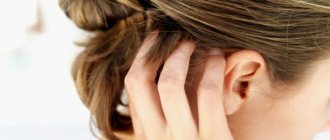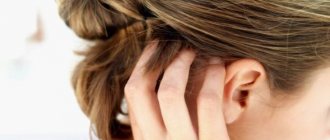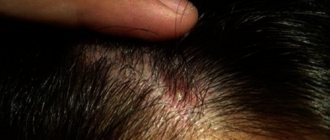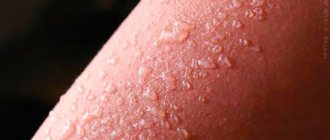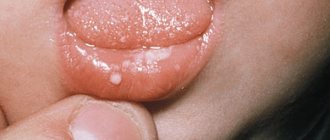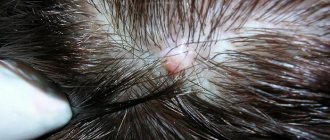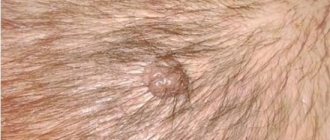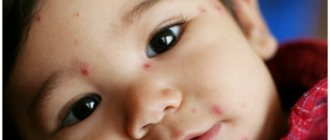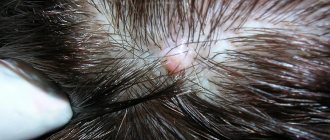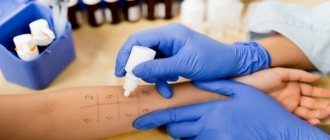Acne does not only occur on the face or body. It is not uncommon for acne to appear on the scalp in the hair.
When scratched, they are easily damaged and infected, which leads to discomfort and pain.
If the disease progresses, unpleasant consequences develop.
Therefore, purulent, rosacea and inflamed acne on the skin under the hair must be treated.
But first, it is important to find out what causes rashes in this area in order to know what treatment methods to use on them.
Why do they appear?
The causes of acne on the head in an adult are the same as on other parts of the body.
Firstly, it is worth excluding malfunctions in the functioning of internal organs and systems:
- hormonal imbalance. Increased activity of the sebaceous glands is affected by excess testosterone or estradiol. In women, this can be observed at the beginning of the menstrual cycle, during pregnancy, after childbirth, and with diseases of the reproductive system (for example, polycystic ovary syndrome). A decrease in the production of sex hormones during menopause also affects the condition of the skin;
- naturally hyperactive sebaceous glands and the production of large amounts of fatty secretion, narrowness of the excretory ducts;
- in men there are dysfunctions of the adrenal glands or pituitary gland;
- stress, overwork, excessive nervous tension for a long period;
- decreased immunity, which occurs after viral and bacterial diseases.
Secondly, you should pay attention to external negative factors that play an important role in the health of the scalp:
- epithelial damage and bacterial infection of wounds;
- reaction to taking barbiturates, steroids, anabolics;
- unbalanced diet - abuse of sweets, cow's milk;
- alcohol and smoking;
- lack or excess of vitamins in the body;
- washing your hair too rarely or often;
- use of shampoos with sodium lauryl sulfate – a comedogenic component;
- allergies to hair dye, skin care cosmetics or chlorinated tap water;
- bed linen, hats made of synthetic fabrics;
- unfavorable environment;
- habit of walking without a hat in cold and frosty weather.
In children
- When a breastfed baby develops small pimples under the hair and itches, the mother needs to reconsider her recent diet. She may have eaten allergenic foods - chocolate, citrus fruits, cocoa, red fruits or vegetables.
- If your baby receives formula, you should consult your pediatrician about changing baby food.
- During the introduction of complementary foods, rashes also appear. Then it is important to find out which product the reaction occurred to, and then exclude it.
- A new shampoo or bath product can trigger itching and flaking.
- If the rash is in the form of bubbles with cloudy contents, then the child is checked for chickenpox.
In any case, the diagnosis must be made by a doctor.
In teenagers
During adolescence, acne may appear in the hair.
- Up to 80% of teenagers 12–18 years old suffer from mild or moderate acne.
- In approximately 15% of them, the disease becomes severe and is complicated by infection.
As you grow older, your body increases the production of testosterone, which affects the functioning of the sebaceous and sweat glands.
The consistency of fat secretion changes. Thick sebum, along with particles of dirt, dust and unexfoliated epidermis, clogs the pores. Bacteria living on the surface of the integument penetrate inside, causing inflammation.
Causes and prevention of pathology
The main reason why a boil occurs on the head is the penetration of Staphylococcus aureus bacteria under the skin. These microorganisms can be present on the skin and mucous membranes, but do not manifest themselves in any way as long as the human immune system is able to resist infection.
Staphylococcus aureus is a bacterium that is resistant to many antiseptics and antibiotics. It does not die when exposed to boiling water, peroxide, or ethyl alcohol and is therefore considered one of the most dangerous bacteria.
Common causes of ulcers:
- Decreased immunity due to colds.
Exacerbation of chronic diseases.- Hormonal imbalances.
- Chronic fatigue.
- Diabetes.
- Impact of bad environment.
- Enduring severe stress.
- Lack of vitamins in the body.
Most often, boils occur on the head, namely on the back of the head, since there are many hair follicles and sweat glands there. Therefore, it is advisable to consider the immediate causes of the formation of pustules on the head:
- Damage to the skin.
- Hypothermia of the head (walking without a hat in the cold or going outside with wet hair).
- Using low-quality hair care products.
- Failure to maintain personal hygiene - using other people's combs and towels.
- Washing your hair too infrequently leads to clogging of the glands, which provokes the development of a favorable environment for the proliferation of bacteria.
- Washing your hair too often can lead to dry skin and the formation of microcracks.
To reduce the risk of boils forming on the head, it is necessary to strengthen the immune system. The first way to a strong immune system is hardening, which will help the body resist not only Staphylococcus aureus, but also other bacteria and viruses.
What other preventive measures are there:
Observe personal hygiene rules.
- Use natural rather than synthetic bedding.
- To refuse from bad habits.
- Avoid stressful situations and physical strain.
- Eat properly and nutritiously.
- Take vitamin and mineral complexes.
- Use proven cosmetic and hygiene products for hair.
These preventive measures will help to avoid not only ulcers on the head, but also strengthen the immune system and prevent a large number of other diseases.
Symptoms
The main sign of the onset of rash formation is itching.
- Within 1–2 days after the onset of the symptom, small red bumps appear.
- They are most often localized on the back of the head, temples, in the upper part of the forehead and in the parting areas.
- Pimples are painful on palpation, accompanied by a feeling of skin tightness and irritation.
- Then maturation occurs. Purulent cavities form inside the elements.
- And after 4–5 days, the thin film on their surface breaks and the contents flow out.
Nodular formations in the form of a rash can be single or located in groups between the mouths of the hair follicles.
Many of them pass without the formation of a purulent nodule.
Types of rashes
Doctors do not have a clear division of rashes into groups.
But for convenience, it is customary to distinguish between comedones and inflamed pimples.
Comedones
These are sebaceous plugs in the gland ducts that rarely cause discomfort.
Blackheads are called open blackheads, and whiteheads are called closedheads. They are almost invisible in the hair.
Inflamed
These are comedones in the cavity of which inflammation has begun.
- They look round and white with a red rim.
- If the infection penetrates deep into the tissues of the dermis, then wen or subcutaneous tissues form there.
Getting rid of them is more difficult.
Why do pustules and pimples appear on the head?
We recommend reading: Hair restoration after dyeing, what to do?
Many people know from school biology courses that the skin has three layers. These are the epidermis, dermis and hypodermis. The sebaceous glands, which are located in the middle layer of the skin, together with other glands, produce secretions that come to the surface of the skin. Thanks to this, a special film appears, protecting the covers from damage. It guarantees hydration and minimizes the likelihood of penetration of harmful bacteria. If there is a hole in such a protective “suit,” bacteria penetrate under the skin and inflammation appears. In most cases, this is possible when the sebaceous glands of the skin work very hard. Most often this occurs during adolescence.
READ ALSO: Nise Gel: instructions for use, active ingredient
How to treat acne on the head in the hair
Like any disease, acne must be treated under the supervision of a doctor.
In addition to the use of medications and folk remedies, it is important to take measures for the speedy healing of acne.
To do this you will have to change your lifestyle.
- Follow a strict diet.
- Give up bad habits - alcohol and smoking. Beer, sweet low-alcohol drinks, and low-quality wines are especially dangerous.
- Treat chronic diseases in a timely manner.
- Be in the fresh air more often, play sports, follow a daily routine, and sleep at least 8 hours a day.
- Eliminate allergens and irritants that cause rashes.
Medication
With the progressive course of the disease, the doctor prescribes systemic medications:
- To normalize hormonal levels, women are advised to use contraceptives. Estradiol therapy is carried out only when a deficiency of the hormone in the blood is detected;
- enterosorbents are used to remove harmful substances from the body (Polysorb, Enterosgel, Lactofiltrum, activated carbon);
- to normalize the functioning of the nervous system - tincture of motherwort, valerian, Glycine, Persen;
- retinoids (Roaccutane) are prescribed in cases where other drugs are ineffective. A synthetic analogue of vitamin A increases the regenerative abilities of epithelial tissues, narrows the ducts of the sebaceous glands and reduces secretion;
- There are multivitamins to strengthen the immune system. Zinc (Zincteral, zinc sulfate), brewer's yeast, calcium, vitamins E, A and C are especially useful.
Antibiotics
The most effective against acne are broad-spectrum systemic antibiotics - Clindamycin, Amoxicillin and Doxycycline (Unidox Solutab).
In practice, Erythromycin, Tetracycline and Lincomycin are often used, despite the fact that they are somewhat outdated.
- Such drugs cope with staphylococcal and streptococcal infections.
- Some of them disrupt the ability of cells to reproduce, others immediately destroy pathogenic flora.
In any case, at the end of the course, lasting protection against bacteria is formed.
Inflammation goes away, pus resolves, pain disappears.
There are also local gels and ointments based on antibiotics:
- Dalatsin;
- Klenzit S;
- Zenerite;
- Bactroban.
The effectiveness of external agents is an order of magnitude lower.
However, they work well for mild to moderate acne symptoms.
Apply them in small portions to the affected areas after washing your hair and drying your hair.
Ichthyol ointment or Levomekol quickly draws out pus.
- The rashes are applied pointwise, trying not to affect healthy skin.
- The product is covered with a bandage and left for several hours.
Rubbing
Recently, retinoids have been used in the fight against acne.
For example, Differin or Adapalene.
To exfoliate the stratum corneum of the epidermis, the skin is wiped with salicylic acid or lotions containing it.
Camphor alcohol has a similar effect.
Ultraviolet
Anti-rash salons often offer ultraviolet treatment.
The radiation not only disinfects, but also dries out pimples and stimulates their maturation.
Cryotherapy
During cryomassage, the elements of the rash are targeted with liquid nitrogen.
This improves blood circulation, weakens the activity of bacteria, and causes cells to recover faster.
Immediately after the procedure, a crust forms on the pimples, which quickly and completely disappears.
Folk remedies
Even if acne on the head in the hair of men and women has different causes, this does not mean that the treatment of the rash is very different.
Especially when it comes to the use of folk remedies. Of course, such methods cannot be perceived as a panacea against the disease.
But as part of a complex effect, they contribute to a speedy recovery.
It is recommended to wipe the skin:
- freshly squeezed strawberry juice to cleanse pores;
- pharmaceutical tincture of calendula, which reduces itching. To avoid causing a burn, 2 tbsp. lie The products are pre-diluted in 200 ml of water.
Washing head
Hair washing should be done as soon as it gets dirty.
For some people, their hair becomes oily the very next day, for others only after 3-4 days. After all, the amount of fat secretion produced varies from person to person.
Be sure to use detergent for washing.
But it is advisable not to buy shampoos with comedogenic ingredients.
It is better to give preference to these products:
- tar soap, which reduces inflammation and disinfects. You can use it 1-2 times a week, as it causes peeling. Pharmacies sell special shampoos with tar;
- soap infusion of walnuts. Take 3-4 nuts, add water and leave for 6 hours. Then they are finely ground, the liquid is stirred and filtered. Use the resulting infusion to wash your hair instead of shampoo. The remaining product is stored in the refrigerator;
- colorless henna, which in the amount of 2 tbsp. lie pour warm water and leave for an hour. Beat 1 chicken or 2 quail eggs, mix the ingredients and apply to the roots, massaging intensively. Then the hair is thoroughly washed.
Rinse
It is important that no shampoo remains on the scalp.
Therefore, the product must be washed off thoroughly. And if washing takes 5–10 minutes, then rinsing your hair with clean running water takes twice as long.
After this, it is recommended to rinse your hair with apple cider vinegar diluted in equal proportions with water or herbal infusion (5 tablespoons per 1 liter of boiling water):
- yarrow;
- plantain;
- sage;
- sequences;
- St. John's wort;
- cornflower;
- oak bark.
Application of oils
- You will need 2 tbsp. lie olive oil with a few drops of lemon or lime juice. The mixture is rubbed into the skin and left for 1 hour. The product moisturizes well and exfoliates dead epithelium.
- Tea tree oil has a powerful effect. It can be used to lubricate large pimples on a spot basis. It is important not to overdo it, otherwise it is easy to cause tissue burns. Also, 2-3 drops are added to medicinal and cosmetic masks.
Masks
Masks are famous for their high efficiency due to the long-term effect of beneficial substances on the skin.
Moreover, the procedures can be done not only for the face, but also to pamper the epithelium of the head.
The following recipes are very popular:
- aloe juice to the skin and hair roots, cover with film and a woolen scarf or cloth, leave for 15–20 minutes;
- pour 100 g of anise seeds with warm water and leave overnight. In the morning, thoroughly grind the swollen raw material and apply to your head. Sit under the film for at least 1 hour, then rinse your hair. It is advisable to repeat the procedure every other day for 2 weeks;
- Art. lie mix honey with 1 tsp. cinnamon and apply to the affected area, rinse after 15 minutes. The mask is done twice a week.
Ointment for acne in hair
Ointment is the most convenient form of release when applied to the scalp with a drying, anti-inflammatory, antibacterial effect. It will quickly relieve itching and irritation, activate the sebaceous glands, and cleanse the pores of accumulated toxins and impurities. The best preparations, despite the presence of a greasy base, after which you have to wash your hair more often:
- gentamicin with an antibiotic effect to combat different strains of bacterial infection (streptococci, staphylococci);
- syntomycin - an excellent antibiotic for suppressing pathogenic microflora with targeted application to pimples, thereby preventing the growth and reproduction of pathogenic microflora;
- salicylic acid to relieve inflammation, applied locally, daily 1-2 hours before washing your hair;
- ichthyol with rapid elimination of pustular lesions, providing an antibacterial effect, despite the specific odor. The skin should be treated shortly before washing your hair (1-2 hours).
Before using any drug, it is wise to first test it for allergies by applying a little on your wrist and waiting 15-20 minutes. To enhance the effect, you can treat the scalp with a solution of salicylic acid or camphor alcohol, rubbing it into the affected areas with massaging movements. Leave for 2-3 hours, then wash your hair using a natural antiseptic (tar) to normalize the functions of the sebaceous glands and suppress pathogenic microflora.
Useful tips
The main emphasis in the treatment of rashes on the head should be on maintaining personal hygiene:
- combs, brushes, hairpins and elastic bands, wigs should be washed with soap at least once a week;
- a clean towel for hair should be separate;
- Bed linen and hats should be washed frequently in hot water;
- dry your hair with a hairdryer, preferably in cold mode;
- combs and brushes should be chosen from natural materials;
- try, as much as possible, to touch your head with your hands, scratch, and tear wounds as little as possible.
Prevention
Precautionary measures to protect against acne on the head:
- It is important to ensure regular hair hygiene;
- select high-quality and hypoallergenic care products;
- lead a healthy lifestyle;
- strengthen the immune system (maintain physical activity, strengthen yourself, take vitamins).
Proper nutrition
- During treatment, fried, smoked foods, marinades, spices, milk, canned food, and sweets should be excluded. Fast food, carbonated drinks, and instant coffee are harmful to the body.
- It is better to cook food by steaming or in a slow cooker. The diet must include fresh fruits and vegetables, lean meats, whole grain cereals, bran and sour milk. Buckwheat, oatmeal and rolled oats are especially useful.
- You need to drink at least 2 liters of purified water per day, which helps remove toxic toxins from the body. You can only drink natural juices, dried fruit compotes, and green tea.
Sources of rash
Human skin has 3 main layers. The first is the epidermis or top layer, the shade of which depends on the characteristics of melanin production. In this area, constant cell renewal occurs.
The second layer is the dermis or middle layer, which is equipped with capillaries, nerve endings, blood and lymph vessels, sweat and sebaceous glands.
And finally, the third layer or hypodermis, in which useful substances are accumulated and stored, thermoregulation of the whole organism occurs.
In the second layer of the skin, the dermis, a sebaceous secretion is produced, released to the surface and ensuring the creation of a hydrolipid film that maintains an optimal level of moisture.
If pathogens penetrate the film, they cause inflammatory processes and ulcers. In most cases, the development of inflammation occurs against the background of excessive activity of the sebaceous glands, which is more often diagnosed in adolescents or with a hereditary predisposition to such a process.
Red pustules in infants occur when a nursing woman does not follow proper nutrition. This is the individual reaction of the newborn’s body to a certain product. Often this phenomenon is diagnosed when the mother eats red vegetables and fruits.
Other causes of ulcers
Other reasons that can cause acne in men and women include:
- the main reason in women is hormonal changes that occur in adolescence, during menstruation, during pregnancy, lactation, menopause;
- disrupted metabolic processes in the body;
- abuse of smoking, alcoholic beverages, drugs;
- improper nutrition with the inclusion in the diet of foods harmful to the skin: fatty, flour, sweets, fast food, etc.;
- pathologies in the gastrointestinal tract;
- purulent acne on the head in the hair - a consequence of using cosmetics that are inappropriate for your skin type;
- irregular hair washing;
- wearing a headdress made of synthetic material, which increases sweating.
In some cases, rashes form due to the uncontrolled use of medications, including systemic ones.
In any case, only a doctor can determine why purulent pimples appeared on the head. It is impossible to independently determine the source of the symptom.
What could be the consequences?
Treatment of rashes on the head should be comprehensive.
If you start the inflammatory process, deep subcutaneous pimples will appear.
Not only are they painful, but they also itch and interfere with living a full life.
After healing, large scars and scars often remain, in place of which hair falls out and no longer grows.
The condition of the scalp is worsened by squeezing, direct sunlight, daily washing and stress.
Does a cucumber mask help with acne? Find out here.
How to get rid of acne on the buttocks? Read on.
kozha.hvatit-bolet.ru
How to treat purulent acne on the head
If a person has single pustules on his head, then this problem can be solved at home on his own. You need to follow two simple steps.
Step #1 – Analysis
Write down on a separate sheet of paper all the foods you eat during the day. Products such as chocolate, alcohol, coffee, smoked and fried foods contribute to the activation of the sebaceous glands on the skin. As a result of excessive sebum secretion, the skin pores on the scalp become clogged. With a balanced diet, the normal functioning of the gastrointestinal tract is restored, which, in turn, reduces the load on the skin. It is worth considering the use of vitamin-mineral complexes, which would serve as a good source of vitamins and microelements for your body.
Take a closer look at the hair care products you use regularly. Shampoo should always be selected according to your hair type. Similarly, you need to decide on the frequency of washing your hair. Do not try to wash them too often, as this will significantly dry out the scalp and cause excessive sebum production. If you wash your hair very rarely, the pores on the skin will become clogged, which will create good conditions for the multiplication of pathogenic microorganisms.
Step No. 2 – Fix the problem
If the pimples are small, you can use tar soap, which is sold in pharmacy kiosks. Soap will make the skin clean without causing irritation, and will also improve blood circulation in the skin.
For large and painful ulcers, you will need antibacterial ointments, which can also be easily purchased at the pharmacy. The ointment is applied to the previously washed and dried inflamed area of the head, after which the bandage is left overnight. Malichthyol ointment is suitable as an analogue of antibacterial ointment.
To eliminate the inflammatory process on the scalp, the old proven method works well: hot salt baths with the addition of sulfur. But since it is very difficult to make such a bath at home yourself, modern industry offers ready-made products containing sulfur. But do not forget that such products use synthetic analogues of sulfur and other natural components. This means that the healing effect of such baths is very relative.
Along the perimeter of the inflamed area, the skin can be treated with camphor or salicylic alcohol - these substances are characterized by anti-inflammatory, antimicrobial and analgesic effects. Although the body may react to these alcohols with an allergic reaction, so they should be applied locally.
When starting to treat and treat pustules and pimples on the head, follow the rules:
- do not squeeze pimples on the scalp, as it is possible that pus will get into the wound and onto the skin, which will lead to re-infection; and if acne is a symptom of a serious (and even viral) disease, then squeezing can lead to complications of the disease;
- Be extremely careful when washing, combing and drying your hair, try to minimize trauma to the inflamed skin areas.
Folk remedies. Infusions of medicinal herbs that have antiseptic and antibacterial properties help against acne on the head: celandine, calendula, yarrow, nettle, etc. After washing with shampoo, you should rinse your hair with the indicated infusions, evenly rubbing them with massage movements into the scalp.
If pustules on the head appear periodically and also spread to other parts of the body, consultation and a comprehensive examination will be required. After which a treatment course will be prescribed, which, as a rule, includes mild antibiotics in combination with antibacterial and antiseptic ointments.
patient.info
What is important to consider during treatment?
We recommend reading: Indian hair cosmetics, what you need to know
If pustules begin to appear on the scalp, then under no circumstances should you squeeze them out. Due to damage to the skin, you can introduce more infections into the wound. If there are too many such manifestations, then they can indicate quite serious problems in the body. Even infection by a virus is possible. Trying to squeeze out pimples will only make the situation worse and treatment will become more difficult.
Maximum attention must be paid at the moment when you wash your scalp. This must be done so gently and delicately so as not to scratch or damage the existing pustules. It is even more important to dry your hair carefully.
Folk remedies and treatment in this case are also relevant. You can use infusions of medicinal herbs such as calendula, yarrow, and celandine. Most often, hair is rinsed with the product after it has been washed.
If simple remedies do not help, and the situation does not improve, but only worsens, then it is still advisable to visit a dermatologist.
READ ALSO: Skin rashes due to liver disease: different types of rashes
Pimples on the scalp
Pimples are inflammatory elements of a rash. They may appear as papules or pustules.
In common parlance, acne refers to any small red rash that rises above the skin. Comedones are identified separately. These are non-inflammatory elements that are most often seen in acne.
Painful pimples cause the greatest discomfort to a person. Along with the rash, other symptoms are possible (itching, burning, redness of the skin, peeling, scarring, purulent discharge).
The causes of acne vary.
The main etiological factors are:
- seborrhea;
- acne;
- hormonal disorders;
- pediculosis;
- furuncle;
- folliculitis.
Sometimes bubbles appear.
This is possible with dermatitis herpetiformis and pemphigus.
Not everyone knows why small pimples appear on the head.
Predisposing factors are:
- lack of personal hygiene;
- occupational hazards;
- increased sweating;
- dysfunction of the sebaceous glands;
- changes in hormonal levels;
- disturbance of nervous regulation;
- adrenal gland diseases;
- polycystic ovary syndrome;
- bearing a child;
- puberty;
- irregular sexual activity;
- presence of thick hair;
- taking steroids;
- using chlorinated water for washing hair;
- smoking;
- using a synthetic fabric pillow;
- stress;
- wearing tight hats;
- infrequent hair washing.
Pimples on the scalp can be caused by allergies or exposure to high temperatures.
Rash due to lice
The causes of the rash may lie in lice. This is a parasitic disease caused by lice and nits. They live on the hair and feed on the blood of the host. Their color ranges from white to brown. Head lice live up to 40 days. Infection occurs through contact. Risk factors are:
- using one comb;
- overcrowding of teams;
- use of one sofa, bed or chair;
- wearing other people's hats;
- non-compliance with hygiene measures in hairdressing salons.
The main symptoms of this pathology are severe itching and the presence of a rash.
The appearance of exanthema is promoted by scratching, infection and lice bites.
With head lice, the hairy area is involved in the process. The rash appears at the sites of insect bites. It has the following features:
- represented by red spots, papules and pustules;
- multiple;
- accompanied by itching.
When infected, ulcers form in the form of pustules or vesicles. In the scalp, the number of rash elements can reach several tens or even hundreds.
A similar clinical picture is often observed in people without a fixed place of residence. Not only pimples, but also pigment spots may appear on the head. Without proper treatment, the skin becomes crusty and rough.
Acne with seborrheic dermatitis
When acne appears on the head in the hair of men, the cause often lies in seborrhea. This is a pathological condition in which sebum production is disrupted. Seborrhea can be oily or dry.
With the first option, purulent pimples on the head appear much more often.
Without proper treatment, seborrheic dermatitis develops.
The appearance of a rash on the head under the hair is due to several reasons.
The main ones are:
- lipid metabolism disorder;
- changes in blood hormone levels;
- burdened heredity;
- excessively frequent hair washing;
- improper care;
- visiting beaches and solariums;
- washing your hair with laundry soap;
- excess fatty and spicy foods in the menu.
HIV-infected people often face this problem. Pregnant women and teenagers also often experience acne in their hair. With seborrhea, the face (chin, nose, forehead) and scalp are affected.
Signs of oily seborrhea in men and women include redness of the skin, oily hair, gaping pores, itching, large dandruff, secretions, hair loss and thickening of the skin.
If a person is not treated in a timely manner, an infection develops. Seborrheic dermatitis develops.
The rash consists of papules (nodules). Pimples on the head are located singly. They are localized in the central part of the seborrheic plaque. Blisters with purulent contents (pustules) often appear. They contribute to itching.
Pimples dry out and form yellow-brown crusts. For such people, their hair quickly becomes oily even with daily showering.
If seborrhea is not cured in a timely manner, the skin of the face becomes involved in the process. In such people it is strewn with acne. This clogs the hair follicles and sebaceous ducts.
Presence of acne
If pimples appear on your head, the cause may be acne. The skin where hair grows and the face is affected. Millions of teenagers have acne.
In recent years, the disease is increasingly detected at the age of 30-35 years. This is a chronic dermatosis that requires long-term and complex treatment.
With this pathology, a rash appears in the head, hair and facial skin. The development of the disease is based on blockage of the mouths of the hair follicles.
Comedones form in the form of blackheads or inflammatory elements (pustules).
They can appear for various reasons.
Predisposing factors are:
- irregular sex life;
- chronic diseases of the gastrointestinal tract;
- pregnancy;
- adolescence;
- abuse of hormonal drugs;
- taking anabolic steroids;
- skin irritation with soap, peelings and scrubs;
- contact with chemicals (herbicides, insecticides, oils).
You need to know not only what causes acne, but also what it looks like. Elements of the rash form in the area of the hair follicle. They are represented by pustules, nodules and nodes up to 10 mm in size. The most common occurrence of acne is on the head. They often disappear by adulthood. The process involves the skin of the forehead, scalp, cheeks, chin and temples.
Self-squeezing pimples leads to the formation of erosions and scars. Ulcers can be single or multiple. In severe cases, their number exceeds 30.
Pimples on the head of men and women rise above the skin, combined with redness and slight swelling of the tissues, red in color. Often the rash causes discomfort to patients due to burning and itching.
Late acne is less common. They occur at 40-50 years of age. In women, they may appear before menstruation.
Against the background of thick seborrhea, spherical red pimples may form on the head. Mostly men are affected. Sometimes acne occurs like facial pyodermatitis, when nodules and papulopustular rashes form in the area of redness.
Over time they merge. Large purulent conglomerates form. Only the face is affected. Sometimes pustules appear on the head of newborns. If proper hygiene measures are taken, they disappear quickly.
Boil in the head area
A common pathology such as a boil on the head is common. It hurts and can cause intoxication of the body. In another way, this abscess is called a boil. It is based on damage to the hair follicle, sebaceous gland and surrounding soft tissues. Boils are painful pimples.
They have the following distinctive features:
- up to 2-3 cm in size;
- painful;
- often accompanied by fever;
- have a purulent core;
- open on their own;
- single or multiple;
- disappear after 7-10 days.
These pimples under the hair rarely appear. The face is most often affected. It all starts with the formation of an area of infiltration (compaction). Swelling occurs.
There may be a slight tingling sensation. Pain occurs on palpation. Purulent pimples appear on the lips, cheeks and chin. In the second stage, suppuration occurs.
A rod is formed. At the top it ends in a pustule. It rises above the skin. Emerging ulcers lead to fever, chills, headache and general malaise.
Intoxication is caused by the proliferation of staphylococci and their entry into the blood. If the ears are damaged, hearing loss may occur. After some time, the pimple on the head opens and the pus comes out. The patients' condition is improving.
Sometimes there are several such pimples on the head. This is called furunculosis. The duration of the disease does not exceed 10 days. The most severe boil is localized in the area of the nasolabial triangle. If acne on the head is not treated, complications develop in the form of erysipelas, carbuncle, phlebitis, lymphadenitis, abscess and phlegmon.
Causes of ulcers and provoking factors in men and women
Pimples are usually localized in the hair on the back of the head; they can appear on the temples and forehead. Less commonly diagnosed are boils on the central part of the head - the crown.
The reasons for the appearance of pustules on the scalp in the hair are similar for men, women, adults and children. The main factor in the formation of abscesses is infection by bacteria, viruses, fungi, and parasitic infections. When microtraumas, scratches, or scratching insect bites occur, potential pathogens of ulcers penetrate into the wound.
Provoking factors for the development of ulcers, bumps, acne in the hair:
- Disruption of the sebaceous glands on the head. Hypersecretion of sebum in combination with slow renewal of the epidermis can accompany bacterial infection.
- Blockage of sweat glands or their hypersecretion. If personal hygiene is poor, sweat creates a favorable environment for the proliferation of bacteria, maceration of the skin with the formation of a wound surface, and infection of hair follicles.
- In women, the cause may be hormonal imbalance during the menstrual cycle, pregnancy, menopause, lactation, taking oral contraceptives, polycystic ovarian disease due to impaired secretion of the hormone estrogen.
- Injuries on the scalp are an entry point for infection, due to which ulcers begin to form.
- Taking hormonal medications, anabolic steroid drugs, long-term course of antibiotics.
- A disrupted diet with a predominance of fast food, sweet carbonated drinks, and fatty foods, which causes disruption of basic metabolism and allergic reactions, the formation of pimples with pus.
- Bad habits - smoking, drinking alcohol, drug addiction - worsen the condition of the skin and weaken the immune system.
- Frequent washing of hair with dry skin provokes the formation of cracks, hair begins to fall out, which is accompanied by the penetration of bacterial flora.
- Allergies to paint, new shampoo, styling products, synthetic materials for bedding, combs, lint hats.
- Overheating from using a hairdryer can cause inflammation of existing acne with degeneration into ulcers and cracks on the scalp.
- Exposure to cold, windy weather negatively affects hair and skin, causing cold rashes.
- Localization of ulcers on the temples may be due to constant wearing of glasses.
- Purulent pimples in the hair on the head of men can be caused by hypersecretion of testosterone, a tendency to hyperproduction of sebum - the hair quickly becomes oily and requires more careful care than in women. When cutting or shaving, the risk of suppuration due to trauma is much higher.
- The danger is represented by diseases of the nervous system and stress factors.
- Pathologies of the adrenal glands and excretory system.
- Gastrointestinal diseases, drug-induced hepatitis.
- HIV status.
- Autoimmune pathology – scleroderma, SLE.
- Endocrine disorders.
- Infectious diseases - rubella, chicken pox.
- Oncological diseases – black pimples, “waxy” bumps.
Pustules in newborns that appear on the body are caused by factors such as:
- past infectious and viral diseases of the mother during pregnancy;
- weakened immunity in the baby;
- sensitive skin:
- heat rash of newborns;
- manifestations of dysbacteriosis;
- exposure to temperature (hypothermia or overheating);
- poor skin care;
- prematurity of the child;
- damage to streptococcal or staphylococcal infection.
In children, acne appears on the head as a reaction to new foods during complementary feeding. Often purulent pimples occur due to excessive consumption of sweets, fatty, spicy and salty foods, iodized salt, and peanuts. The substances found in these products increase sebum production. Excess fat causes clogged pores or hair follicles.
Purulent acne can appear on the skin for various reasons. The main reason is the increased production of subcutaneous fat; it clogs the pores, in which the inflammatory process begins to develop. Skin blockage in the first stages is not dangerous, but in pores clogged with grease and dust, bacteria begin to develop, and they are the cause of inflammation.
- hormonal changes in the body;
- diseases of the gastrointestinal tract;
- nervous system disorders.
READ ALSO: Streptoderma in children - causes, symptoms and treatment
External reasons include:
- microtraumas, abrasions, cuts;
- pore contamination;
- excessive dry skin.
A swelling appears at the site of the pimple, which begins to swell. A purulent core forms inside. Until it comes to the surface, the person is bothered by acute pain. As soon as the pus comes out of the pimple, the pain will begin to subside.
Methods of examining patients
Treatment should begin once the cause of the rash has been determined. If you have blisters in your hair, you will need the following tests:
- general clinical tests;
- dermatoscopy;
- blood chemistry;
- study of hormonal levels;
- analysis of feces for dysbacteriosis.
If necessary, an endoscopic examination of the intestine is performed.
If there are pustules on the head in the hair, treatment begins after interviewing the patient.
You need to find out the following information:
- when and under what conditions the rash appeared;
- what shampoo and personal hygiene products the patient uses;
- whether there are chronic diseases;
- chief complaints;
- occupational hazards.
The medical history is very important for the attending physician. It allows you to identify risk factors for the occurrence of purulent acne on the head in the hair. Most diseases can be identified through a skin examination and interview. A hormone test is required.
If pimples with purulent discharge appear on the head, a bacteriological examination may be necessary. It allows you to identify the pathogen. Most often these are staphylococci, streptococci and mixed microflora.
Ulcers in a child
Pustules on the face of a newborn are a fairly common occurrence; they may have the following causes:
- Hormonal rash. The baby's hormonal levels are developing. During this period, the appearance of small pustules on the face is possible.
- Allergy. If the child is breastfed, the mother must carefully monitor her diet so as not to provoke an allergic reaction in the baby.
- Prickly heat. A newborn's skin is very delicate and if proper hygiene is not maintained, rashes can occur all over the body.
- Excessive activity of the sebaceous glands. A non-dangerous condition that does not affect the child’s health in any way.
- Dysbacteriosis. Develops when microflora is disturbed.
- Infections. Staphylococcus, streptoderma.
- Infections that are transmitted by airborne droplets - measles, chickenpox, rubella, and so on.
If a child has pustules on his face, it is necessary to consult a pediatrician. Most likely, there is nothing dangerous, but it is better to exclude infectious and fungal infections.
Pustules on the face of a child in the first years of life can be the result of the following:
In children of preschool and school age, pustules rarely appear, and the skin remains clear until adolescence. But in some cases, pustules still appear and are clinical manifestations:
All these pathologies require specialist consultation and quality treatment.
Ways to get rid of acne
For acne on the head, treatment is selected individually for each patient, depending on the main cause of the rash. For single boils, local therapy is carried out. During the infiltration phase, the skin is wiped with a swab soaked in alcohol. The boil itself is cauterized with an iodine solution. Dry heat is applied. Physiotherapy may be performed.
During the maturation stage, bandages with ichthyol ointment are applied. If the necrotic rod does not come off well, then enzyme preparations are prescribed. Salicylic acid is often used. After opening the pimple on the head, treatment involves applying bandages with a hypertonic solution. Additionally, healing ointments are prescribed.
During the healing phase of a pimple on the scalp, antibacterial agents are indicated. For frequent relapses and multiple boils, immunostimulants are prescribed.
Toxoid and vaccine may be administered. If there are multiple pimples on the head in the hair (boils) and symptoms of intoxication are pronounced, then systemic antibiotics (penicillins, macrolides, cephalosporins) are used.
Not everyone knows how to treat head lice. For this disease, the skin is treated with antiparasitic drugs in the form of sprays, lotions, aerosols, ointments or shampoos.
If acne on the head itches against the background of lice, then medications such as Para Plus, Nittifor and Nyx are prescribed. They have a detrimental effect on adult lice and nits. When prescribing a medication, the patient's age, tolerability and contraindications are taken into account.
To make the rash less itchy, antihistamines are prescribed. Pimples on the back of the head in men due to seborrhea require a diet limiting fried, spicy and fatty foods, the use of antifungal drugs, treatment of existing diseases of the stomach and intestines, the use of zinc and tar-based products, cryomassage and physiotherapy.
In severe cases, keratolytic drugs are prescribed.
Treatment
A doctor will not be able to make a correct diagnosis based on photo symptoms alone.
Additional studies are prescribed to determine the cause of the rash, and information is collected about previous factors that could cause the formation of acne.
Physiological reasons
How to treat a rash if it is caused by a malfunction of the gastrointestinal tract? First of all, the abuse of the wrong foods affects the condition of the skin. In this case, a review of the diet is required. It includes fruits and vegetables, foods with unsaturated fats. Fatty foods, fried and smoked foods are consumed in minimal quantities.
If neoplasms appear due to the use of cosmetics that are unsuitable for your skin type, it is important to choose the right product. It is also worth regulating the frequency of taking water procedures. Experts recommend washing your hair at least 2 times a week.
Women are advised to carefully select hair dyes and monitor the skin's reaction to a particular product. Before using them, it is better to test for an allergic reaction.
Pathological causes
If acne on the head is caused by a specific disease, treatment is carried out based on its type.
First of all, medications are prescribed:
- if hormonal levels are disturbed, use drugs containing hormonal components (Duphaston, etc.);
- if the activity of the digestive tract is disrupted, enterosorbents are prescribed (Polysorb, etc.);
- if liver activity is impaired, hepatoprotectors are used (Essentiale, etc.);
- if the intestinal and gastric microflora is disturbed, you need to take enzymes (Festal, etc.) and probiotics (Linex, etc.);
- if a herpetic infection develops, antiviral drugs are prescribed (Acyclovir, etc.);
- if the activity of the immune system is reduced, immunostimulants (Cycloferon, etc.) will come to the rescue;
- if a bacterial infection develops, antibiotics are prescribed (Doxycycline, etc.).
In combination with drug therapy, it is recommended to provide proper hygiene care and begin to adhere to proper nutrition.
You can supplement the main treatment with folk remedies. When washing your hair, it is recommended to replace regular shampoo with tar soap, which dries out the epidermis on the head and the new growths present on it.
Apple cider vinegar from which a solution is prepared will be effective: 100 g of vinegar for the same amount of warm water. Rinse your hair with the prepared product after shampooing. Medicinal herbs are also useful, indispensable for preparing decoctions and infusions, which are also used to rinse the head.
Conclusion
Any remedy for the treatment of purulent acne on the head, including folk remedies, is recommended to be discussed with a doctor before use. Incorrect therapy will not only slow down recovery, but also cause additional harm to health.
Rash prevention methods
Red and white pimples on the scalp can be prevented. To do this you need:
- wash your hair regularly with warm water;
- do not use steroids;
- exercise;
- choose the optimal shampoo for your hair;
- eliminate stressful situations;
- treat diseases of the digestive system;
- exclude head injuries;
- do not use other people’s hats, pillows and combs;
- drink vitamins;
- eat well;
- normalize hormonal levels;
- no smoking.
To prevent purulent complications, acne treatment should begin at the first symptoms. Thus, ulcers on the head in the hair can be a sign of various diseases.
doctoros.ru
Videos about ulcers in the hair on the head
The author of the video will share information with viewers about how to treat ulcers on the head:
Elena Malysheva will tell viewers about ulcers in the hair on the head, their treatment, causes of appearance, and symptoms:
Since I was 15 years old, I have been suffering from ulcers on my head, especially in the summer when it is hot. Significantly reduced rashes using aloe juice and eliminating fatty foods from the diet. And after ultraviolet therapy they disappeared altogether, but not for long, so I repeat the procedures periodically
News MirTesen
Previous articleLipoma: what is it according to ICD 10: what it looks like and how to treat
Next articleIs it possible to smear a boil with iodine: what will be the consequences if you burn a boil?
Irina Beresneva
THIS MAY BE INTERESTING MORE FROM THE AUTHOR
Problem skin
Rash in the groin of a child - irritation in the intimate area, redness and itching on the genitals
Problem skin
Lipoma removal surgery - “Instead of 20 minutes - 1 hour lipoma removal surgery
Problem skin
A newborn has a rash on the face and head: what is it?
LEAVE A REPLY Cancel reply
You'll like it!
Problem skin
Boil (furuncle) on the eye: photo of eyelids, how to treat
Problem skin
Dermatitis: photos, symptoms and treatment for adults at home
Fashion & Style
With humor: the wife of Alexander Tsekalo responded to rumors about pregnancy
Health
How to treat drug addiction
Problem skin
Pimples after sunbathing: why they appeared on the back, shoulders, chest, small, red,…
Body care
Why does foot fungus need to be treated with tablets, and which ones are most effective?
Editor's Choice
Orchis benefits
Miscellaneous 09/04/2020
Winter manicure, fashionable in the 2020-2021 season
Beauty 09/03/2020
Where to buy a beautiful dress
Fashion and style 09/03/2020
Popular posts
Pimples on and around the nipples in women - photos and...
Beauty 03/26/2020
Pimples broke out on the face - sharply, a lot, reasons, small, severe, red,...
Beauty 03/26/2020
Pimples on the arms from shoulder to elbow: all the reasons with photos...
Beauty 03/26/2020
